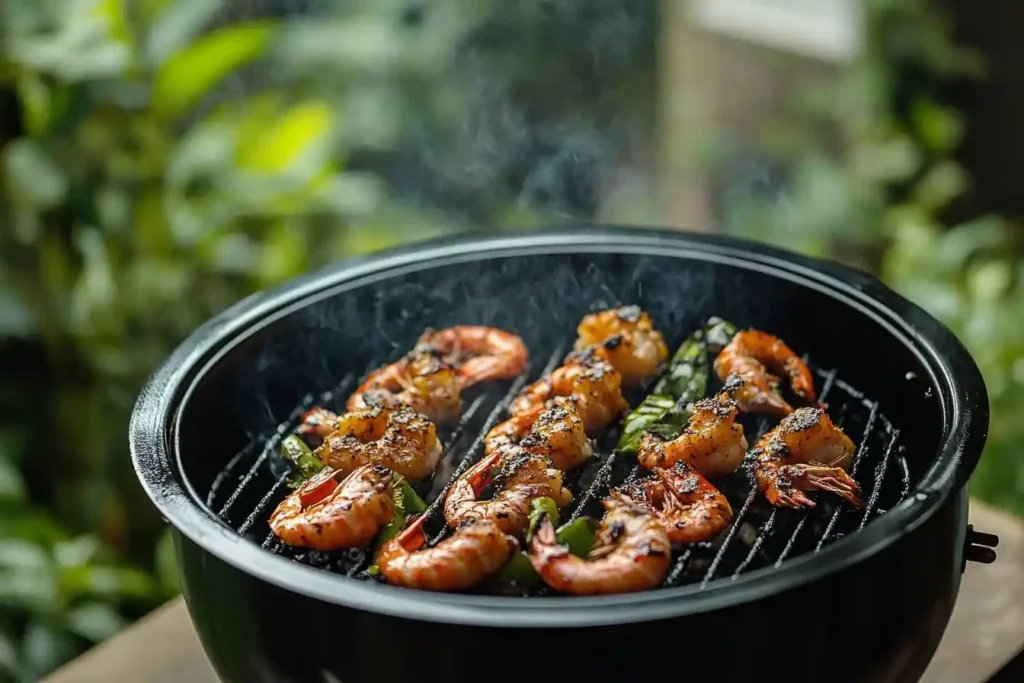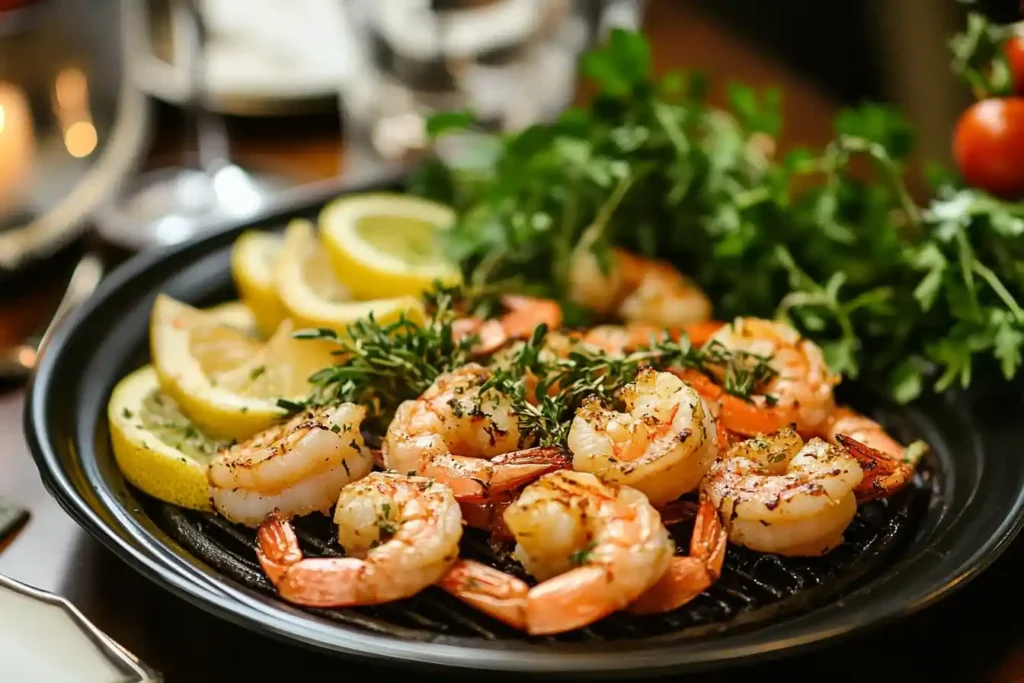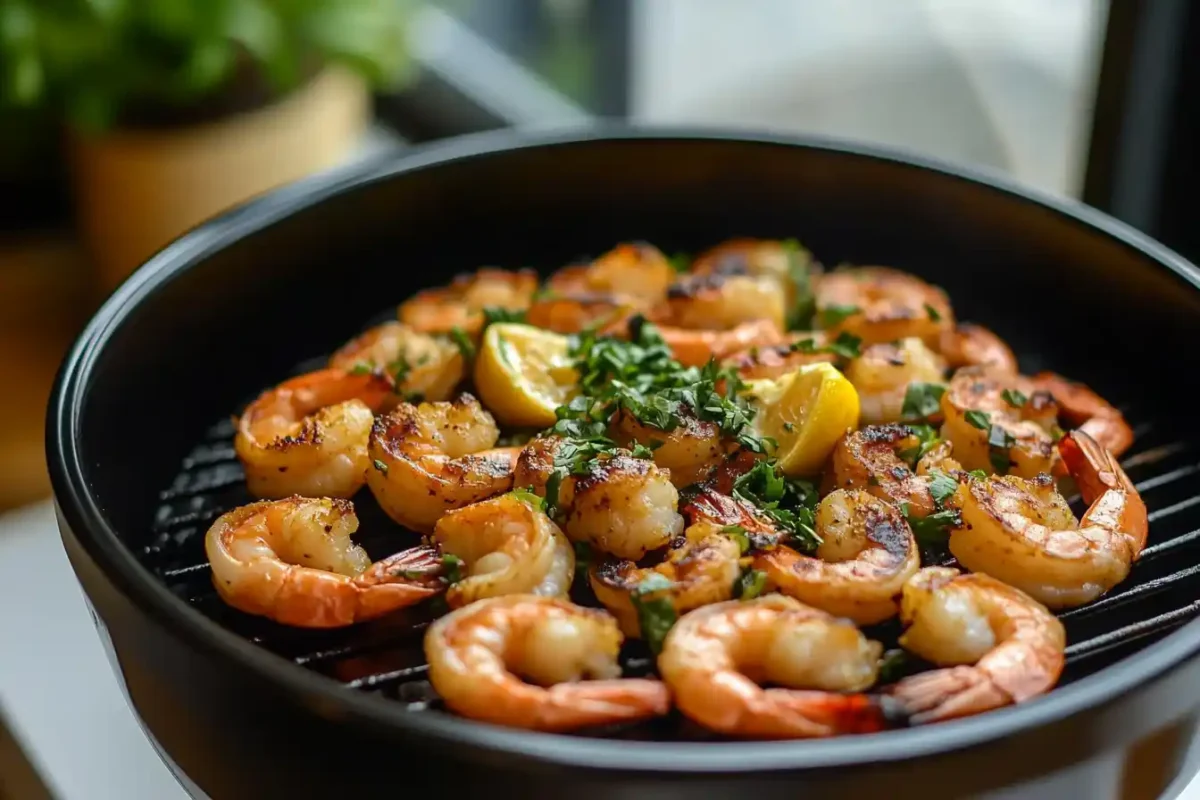Discover easy tips, marinade ideas, and grilling methods for perfectly tender, flavorful barbecued shrimp every time. For an in-depth guide on achieving grilling perfection, check out The Ultimate BBQ Shrimp Recipe: Perfect for Every Grill Master and elevate your outdoor cooking game.
What is the best way to barbecue shrimp? Many grilling enthusiasts often ask this question, hoping to find that perfect balance of taste, texture, and aroma. Shrimp, with its tender flesh and sweet flavor, adapts well to outdoor cooking. Indeed, it is a staple among U.S.-based barbecue lovers looking to diversify their weekend cookouts.
Many people worry about overcooking shrimp, but you can avoid a rubbery texture by watching the timing carefully. Choosing fresh, high-quality shrimp also makes a big difference in taste. This guide covers everything you need: how to pick, prepare, marinate, cook, and season shrimp, along with serving ideas. Since there are so many ways to make grilled shrimp delicious, let’s dive in and find the best method for you.
In this section, we’ll cover the basics of barbecuing shrimp. You’ll learn how to choose the freshest shrimp, clean and prepare them, and pick the right grilling tools. Mastering these steps will help you grill shrimp perfectly every time.
Understanding the Basics of Barbecuing Shrimp
What is the best way to barbecue shrimp? Undoubtedly, it starts with the fundamentals. In the subsequent chapter, we examine how to choose, prep, and season shrimp before it ever touches the grill.
Selecting the Right Shrimp
Firstly, size matters. Generally, larger shrimp are easier to grill because they can handle high heat without overcooking too fast. Conversely, smaller shrimp cook quicker, leaving less margin for error. Chiefly, you must consider your skill level and desired presentation. If you want succulent, meaty bites, opt for jumbo or extra-large shrimp.
Freshness is key when choosing shrimp. Fresh shrimp should smell clean, like the ocean, and have firm, translucent flesh. While previously frozen shrimp can also be good, make sure they’re thawed properly—ideally overnight in the fridge. Wild-caught shrimp often have a richer flavor compared to farm-raised ones. However, farm-raised shrimp can still be delicious, especially if they come from trusted suppliers.
Importance of Quality and Freshness
But how do you ensure top quality? Evidently, purchasing shrimp from trusted fishmongers or reliable supermarkets helps. Equally, checking labels for sustainable fishing methods ensures environmental responsibility. Lest you forget, shrimp should never smell like ammonia. Otherwise, discard it immediately.
Though shrimp must be fresh, properly cleaning them is essential. During the preparation stage, rinse them gently under cold water. Then pat them dry with paper towels. Markedly, dryness helps them form a pleasing crust on the grill.
Cleaning and Deveining Shrimp
In the next part, we’ll cover how to clean shrimp. While some prefer to grill shrimp with the shell on, most people remove the shell and devein them. This not only improves the texture but also makes the shrimp easier to eat. To devein, use a paring knife to cut along the shrimp’s back and remove the dark vein. Rinse the shrimp quickly to remove any remaining grit.
Leaving the tail on can enhance presentation and provides a convenient “handle” for eating. However, whether to leave the tail on or off comes down to personal preference. Another factor to consider is how well the marinade can soak in. Generally, shrimp without shells absorb flavors more effectively.
Prepping Shrimp for the Grill
In the following segment, it’s time to prepare for the grill. Before marinating, pat shrimp dry to remove moisture. Moisture can dilute seasonings and prevent a proper sear. Concurrently, think about how you will place them on the grill. Skewers keep shrimp organized and prevent them from falling through grates. Similarly, grill baskets or foil packets can be used. Certainly, these tools make flipping and removing shrimp easier.
Once you’ve prepared the shrimp, season or marinate them just before grilling. Short marination times are best because acidic marinades can start ‘cooking’ the shrimp too early. Aim for about 15-30 minutes, and then you’re ready to grill.
Moving to the next part, we’ll explore grilling equipment. Different grills offer distinct advantages. Knowing how to choose and care for your grill ensures better results.

Equipment Needed for barbecue shrimp
What is the best way to barbecue shrimp? It helps to have the right gear. Notwithstanding your preference for gas or charcoal, the right tools make all the difference.
Choosing the Right Grill
Thereafter, let’s consider grill types. Charcoal grills impart a smoky flavor that many adore. Gas grills, on the other hand, offer consistent heat and easy temperature control. If you want a convenient indoor option, a grill pan or electric grill might suffice. Correspondingly, pellet or infrared grills also exist, providing different heat profiles. Choose according to your taste, skill, and available space.
Essential Grill Accessories
In the next phase, gather accessories. A sturdy pair of tongs allows precise control when flipping shrimp. A grill brush keeps grates clean. High-quality skewers prevent shrimp from rolling. Comparatively, metal skewers last longer and conduct heat, helping cook from within. Wooden skewers should be soaked to prevent burning. Surely, having a reliable instant-read thermometer helps ensure shrimp is never overcooked.
Grill Safety and Maintenance
In the succeeding section, remember grill safety. Before cooking, clean and preheat the grates. Oiling them prevents sticking. Nevertheless, watch for flare-ups caused by dripping fats. Keep a spray bottle of water handy. Also, ensure proper ventilation. In short, a well-maintained, safe grill is essential for perfect barbecue shrimp.
In the ensuing segment, we’ll examine marinades and seasoning techniques. Flavor customization is where shrimp truly shine.
Seasoning and Marinades for Perfect Barbecue Shrimp
What is the best way to barbecue shrimp? Besides cooking technique, flavor is everything. Shrimp’s mild flavor welcomes various seasonings and marinades.
Simple Salt-and-Pepper Seasonings
Sometimes less is more. Although complex marinades are delightful, a basic approach allows shrimp’s natural sweetness to shine. Salt and pepper, applied evenly, can be enough. Before you cook, just lightly oil the shrimp. Indeed, a minimalistic approach emphasizes shrimp quality.
Classic Marinades and Brines
But maybe you want more complexity. A citrus-herb marinade, for example, brightens shrimp with lemon, lime, and fresh herbs. Garlic and butter add richness, while Cajun or Creole blends bring heat and depth. Contrarily, a salty brine can enhance texture. By soaking shrimp briefly, the brine locks in moisture and yields juicier results.
International Flavor Profiles
Furthermore, shrimp takes on global flavors effortlessly. Asian-inspired marinades with soy sauce, ginger, and sesame oil add savory depth. Mediterranean choices like olive oil, oregano, and lemon zest evoke a sunny, coastal vibe. Additionally, Caribbean jerk or tropical fruit-based mixes deliver sweet and spicy accents. Basically, you can travel the world through your grill.
Marinating Times and Tips
Be careful with marinating times. Around 15-30 minutes is usually enough. If shrimp sit too long in acidic marinades, they can turn mushy. Use oil-based marinades to keep them flavorful and moist. Before grilling, pat the shrimp dry for a better sear. While cooking, you can brush on some leftover marinade for extra flavor, but make sure it’s fully cooked for safety.
Transitioning to the subsequent portion, we focus on the cooking techniques themselves. Knowing how to manage heat and time is crucial for succulent barbecued shrimp.
Cooking Techniques for barbecue shrimp
What is the best way to barbecue shrimp? It hinges on applying the right cooking method. Although shrimp cooks quickly, mastering a few techniques ensures it’s never overdone.
Direct Grilling on High Heat
Forthwith, consider direct grilling. High heat sears shrimp’s exterior, creating caramelized edges. Since shrimp is small, it only needs a minute or two per side. Markedly, keep your tongs ready. Flip shrimp promptly, and remove them as soon as they turn opaque and pink. Till that point, remain attentive.
Indirect Heat Methods
Alternatively, indirect heat helps when grilling larger shrimp or using foil packets. Place shrimp away from direct flames, allowing them to cook gently. This method prevents scorching and allows seasonings to infuse. Occasionally add wood chips for a subtle smoky flavor. Hence, indirect grilling works well for experimenting with different taste profiles.
Using Skewers for Even Cooking
Surely, skewers make grilling shrimp simpler. Thread shrimp on skewers so they lay flat and secure. For added flair, intersperse vegetables or pineapple chunks. Consequently, you get a colorful, balanced dish. Also, consider double-skewering shrimp to prevent them from spinning when flipped.
Advanced Methods and Tricks
To take your grilled shrimp up a notch, try basting them as they cook. Generously brush melted butter or marinade over the shrimp for extra flavor. For more aroma, use herb brushes or smoke packets. You can also experiment with grill zones: use a hotter side to sear the shrimp and a cooler side to finish cooking for the perfect texture.
Proceeding to the next chapter, we’ll look closely at how to achieve perfect texture and flavor every time. Timing and attention are key.
Ensuring Perfect Texture and Flavor in Barbecue Shrimp
What is the best way to barbecue shrimp? It means striking the right balance: succulent, tender flesh infused with smoke and seasoning.
Avoiding Overcooking
Overcooking shrimp leads to toughness. Notwithstanding how tempting it is to leave them longer, trust your intuition. When shrimp turn opaque and curl into a “C” shape, they’re done. Generally, their internal temperature should reach around 120-140°F. Use a thermometer if unsure. Otherwise, rely on color and firmness. Doubtedly, practice makes perfect.
Balancing Smoke, Char, and Seasoning
Comparatively, seasoning must not overpower shrimp. If you taste only marinade and char, you missed the shrimp’s natural sweetness. Instead, adjust seasoning gradually. Because shrimp cooks fast, it’s easy to add a bit more salt or a squeeze of lemon at the end. Moreover, control char by moving shrimp to cooler grill zones if they brown too fast.
Resting Shrimp Briefly Before Serving
Although shrimp is small, a brief rest—just a minute or two—lets juices settle. Afterwards, flavors mingle, ensuring each bite is balanced and moist. Altogether, this small step can make a noticeable difference.
In the next installment, we discuss serving suggestions. The right sides, sauces, and beverages can turn grilled shrimp into a complete meal.
“Serving Suggestions and Side Dishes: What is the Best Way to Barbecue Shrimp?”
What is the best way to barbecue shrimp? Make it a feast. While shrimp alone is tasty, pairing it with complementary sides and sauces elevates the dining experience.
Pairing Shrimp with Complementary Sauces
Serve shrimp with classic cocktail sauce for a familiar flavor. Alternatively, try chimichurri or romesco for herbaceous or nutty depth. Identically, a garlic-herb butter dip enriches shrimp’s sweetness. Basically, choose sauces that highlight shrimp rather than overpower it.
Ideal Sides and Accompaniments
Alongside shrimp, offer fresh salads—arugula, tomato, and avocado bring brightness. Similarly, grilled vegetables like zucchini, bell peppers, and corn provide a hearty, colorful backdrop. Additionally, consider light grains like rice pilaf or couscous to soak up juices. Contrarily, heavier sides might overshadow shrimp’s delicate nature.

Troubleshooting Common Barbecue Shrimp Issues
What is the best way to barbecue shrimp? Sometimes, challenges arise. Notwithstanding your best efforts, shrimp might turn dry or bland. Let’s fix that.
Dealing with Dry or Tough Shrimp
If your shrimp seems tough, you probably overcooked it. Try reducing cook time by 30 seconds on each side. Furthermore, increase marinade fat content with butter or olive oil. Another solution is marinating a shorter time if acid was involved.
Preventing Shrimp from Sticking to the Grill
If shrimp sticks to the grates, ensure they’re oiled and preheated. Comparatively, non-stick grill mats or lightly oiled foil help. Also, avoid moving shrimp too soon. Once they develop a sear, they release more easily. If they still cling, turn down heat slightly.
Fixing Bland Flavor
If your shrimp tastes bland, you might have under-seasoned. Add a finishing sprinkle of sea salt or a squeeze of fresh lemon juice. Also, next time, marinate longer or choose a bolder marinade. Similarly, serve a flavorful sauce alongside.
Transitioning to the subsequent portion, let’s consider health and safety. Proper handling ensures shrimp tastes great and won’t make anyone ill.
Health and Safety Considerations
What is the best way to barbecue shrimp? Safe handling and healthy methods matter. Undoubtedly, following guidelines protects your guests and preserves flavor.
“Food Safety Guidelines: What is the Best Way to Barbecue Shrimp?”
First, store shrimp properly. Keep it chilled and cook it as soon as possible after thawing. Cook shrimp to a safe internal temperature. Because shrimp is delicate, ensure it’s sourced from reputable places. Also, never reuse raw marinade unless it’s boiled first to kill bacteria.
“Healthy Preparation Techniques: What is the Best Way to Barbecue Shrimp?”
For a healthier dish, use less oil or butter. Instead, rely on herbs and spices for flavor. Likewise, incorporate antioxidant-rich ingredients like garlic and fresh herbs. Moderation is key—shrimp is low in saturated fat and can be part of a balanced diet.
Dietary Restrictions and Alternatives
Many guests may have dietary concerns. Presently, gluten-free marinades are easy to create by avoiding certain sauces. If salt intake is an issue, reduce sodium or choose herbs over salt. Ultimately, customizing recipes ensures everyone enjoys the meal.
Proceeding to the next chapter, we will answer common questions that people often ask. These FAQs address shell-on vs. shell-off choices, cooking time, moisture retention, and raw vs. pre-cooked shrimp grilling.
Frequently Asked Questions (FAQ) on Barbecue Shrimp
Is it better to barbecue shrimp with shell on or off?
Albeit both methods work, shell-on shrimp tend to retain more moisture and flavor. However, they can be messier to eat. Conversely, shell-off shrimp absorb marinades more directly and are easier to eat. Which you choose depends on preference. If you want intense flavor and juiciness, grill with the shell on. If convenience and marinade penetration matter more, remove it.
How long should you BBQ shrimp for?
In general, shrimp cook very quickly. Usually 1-2 minutes per side over medium-high heat suffices. Watch closely, though. Once the shrimp turn pink and opaque, remove them promptly. Overcooking leads to rubbery texture. Overall, brief high-heat cooking is best.
How do you keep shrimp moist on the grill?
To keep shrimp moist, marinate them in an oil-based mixture. Also, grill over high heat for a short time. Do not leave them on the grill too long. If desired, brush melted butter or reserved marinade over them while cooking. Resting them briefly after grilling also helps lock in juices.
Is it better to grill raw or cooked shrimp?
It’s preferable to grill raw shrimp. Raw shrimp allows you to develop flavor from scratch and control cooking time. Pre-cooked shrimp often turn rubbery when heated again. Unless you need a quick option, choose raw shrimp for the best texture and flavor.
The Conclusion of Barbecue Shrimp
What is the best way to barbecue shrimp? Surely, it involves a combination of fresh shrimp, proper preparation, seasoning, and precise grilling. By starting with high-quality shrimp, cleaning them well, and choosing suitable marinades, you set the stage for success. Furthermore, having the right grill and tools helps ensure even cooking. Paying attention to timing, heat, and marination leads to a perfect char and juicy texture.
Another important aspect is complementing shrimp with sauces, sides, and beverages. By understanding potential pitfalls and how to fix them, you’ll continue to improve. Overall, you now have the knowledge to confidently fire up the grill and produce succulent, flavorful barbecue shrimp every time.
Remember, practice makes perfect. Experiment with flavors, try new marinades, and tweak cooking times. Eventually, you’ll master the art of grilling shrimp, delighting friends, family, and yourself with each savory bite.

